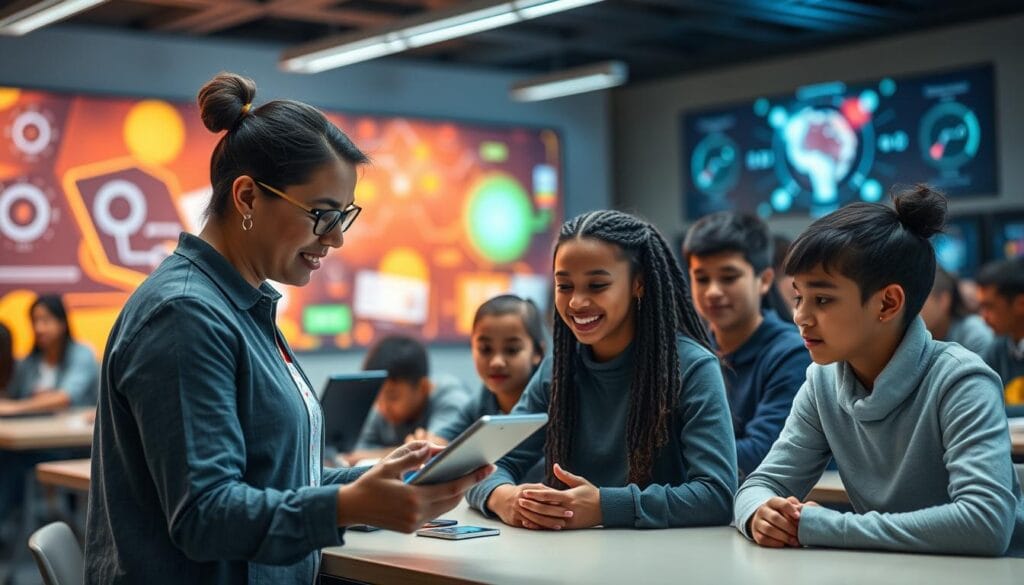AI in education is more than a trend; it’s a major change that will shape learning’s future. Educational technology is advancing fast, leading to a new era in teaching and learning. Education is moving beyond old ways, and AI is leading this change.
AI offers customized learning paths for students. It also gives teachers new tools to make learning more engaging. As we move forward, knowing how AI fits into education is key. This article explores how AI is changing education, preparing students to lead in an AI-driven world.
Key Takeaways
- AI is reshaping traditional education models.
- Empowers students with personalized learning experiences.
- Equips educators with innovative teaching tools.
- Prepares learners for an AI-driven workforce.
- Highlights the importance of AI literacy in future curricula.
The Current Landscape of Education and AI
The world of education is changing fast, thanks to new tech. Old ways of teaching, like classroom lessons, are being updated. Now, AI is changing how we learn.
Overview of Traditional Education Models
Many schools still use old teaching methods. They focus on set curricula and tests that test memory. Teachers teach, and students listen, with little chance to learn differently.
How AI is Being Integrated into Current Systems
AI is now in schools, changing how we teach and learn. It helps teachers and students in many ways. AI can grade papers and give one-on-one help to students.
It also gives teachers insights to teach better. As students use AI for homework, teachers must learn to use it too. This makes learning more exciting and personal.
How AI Can Shape the Future of Education
AI in education is changing the game with hyperpersonalization. This means learning experiences are made just for each student. AI tools adjust content and teaching methods based on how well a student is doing and what they like.
This makes learning more accessible for everyone. It’s a big step towards making education inclusive for all.
Hyperpersonalization in Learning
Hyperpersonalization is changing how we learn. Students can learn at their own speed, making learning more exciting. AI helps create learning paths that fit each student’s needs.
These systems check how well students are doing and change what they learn. This way, students can dive into subjects they love, which helps them stay motivated and learn more.
AI-Enabled Tools for Students and Educators
AI tools like virtual tutors and smart tests are key in today’s classrooms. They help teachers by doing the boring stuff and showing how students are doing. This lets teachers spend more time with students, helping them in the best way possible.
As education moves online, these tools are essential. They open doors to learning that lasts a lifetime. Students can keep learning new things and skills forever.
Benefits of AI in Educational Settings
AI technology has changed education, bringing big benefits. It makes learning more engaging, helps with school tasks, and supports learning for life. Schools using AI offer unique experiences for both students and teachers.
Enhancing Student Engagement
AI systems make learning fun by offering lessons that fit each student’s needs. This personal touch keeps students interested and eager to learn. It helps them stay motivated and involved in their studies.
Streamlining Administrative Tasks for Educators
AI helps with tasks like grading and planning classes, saving teachers a lot of time. This lets them focus more on teaching and helping students. It makes schools run smoother, allowing teachers to do what they love most.
Promoting Lifelong Learning Opportunities
Today’s job world is always changing, making lifelong learning key. AI offers tools for learning new skills or knowledge. It helps people keep up with industry changes and enjoy the benefits of AI.

| AI Benefits | Impact on Education |
|---|---|
| Enhanced Student Engagement | Personalized learning experiences |
| Administrative Efficiency | Automated grading and scheduling |
| Lifelong Learning | Continuous education opportunities |
Challenges Educators Face with AI Adoption
AI in education has great potential, but big hurdles stand in the way. Teachers often face pushback when trying to use new tech in their classrooms. This makes it hard to use tools that could make learning better.
Resistance to Change in Traditional Education
Teachers are used to old ways of teaching. Moving to new methods makes them nervous. They might feel they can’t handle the latest tech.
It’s key to give teachers the training they need. This way, they can use AI tools with confidence.
Equity and Access to AI Resources
There’s a big gap in who has access to tech in schools. Richer schools have the latest tools, while poorer ones don’t. This is a big problem for fairness in education.
We need to make sure all students can use AI tools. This means making tech more available to everyone. It’s important for a fair education for all.

In the end, we must overcome the fear of change and make sure everyone has access to tech. This is the key to unlocking AI’s full potential in schools.
The Role of Teachers in an AI-Driven Classroom
Education is changing with the help of artificial intelligence. Some worry that teachers might lose their roles as machines become more important. But, teachers are essential in an AI-driven classroom. They use technology to make learning better and guide students in unique ways.
AI as a Supportive Tool, Not a Replacement
AI is a great addition to teaching, not a replacement. It helps teachers create learning plans that fit each student’s needs. This teamwork makes learning exciting and effective. Teachers still use their skills to understand students and adjust lessons, keeping human touch in education.
Developing Critical Soft Skills in Students
Teachers will focus more on teaching soft skills like creativity and teamwork. These skills are key as technology advances. In an AI world, being able to work well with others is just as important as knowing how to use technology. Teachers will help students develop these essential skills.

| Teacher Contributions | AI Contributions |
|---|---|
| Fostering critical thinking and creativity | Providing data-driven insights for personalized learning |
| Encouraging collaboration among students | Automating administrative tasks to free up teacher time |
| Integrating ethical considerations in learning | Enhancing resource accessibility and engagement |
| Developing social-emotional skills | Supporting diverse learning styles |
Generative AI and Its Impact on Learning Experiences
Generative AI is changing how we learn, making education more interactive. Tools like ChatGPT give students quick access to information. This helps them dive deeper into their studies and get more involved.
These tools don’t just help students understand better. They also make learning more fun and engaging. This is a big step forward in improving how we learn.
How Generative AI Tools Enhance Understanding
Generative AI tools change how we interact with learning materials. They offer personalized answers to questions, helping students grasp tough topics. This makes learning more flexible and less scary.
As these tools get better, they fit different learning styles. This makes learning easier and more enjoyable. It also encourages students to explore and learn more.
Possible Pitfalls of AI in Assignments
But, there are downsides to using AI in school. Relying too much on AI can hurt writing skills. Students might not think as much or be as creative.
Schools need to be careful when using these tools. They should make sure AI helps, not hinders, traditional learning. Teachers need to talk about this to find the right balance.
Integrating AI into Curriculum and Assessment
Adding AI to curriculum design is exciting for teachers. It lets them use technology to make learning better and keep it fair. It’s important to use AI right to help students in different ways.
Best Practices for Educators
Teachers should follow some key steps for AI to work well. These include:
- Talking to people to get their views on teaching.
- Using AI tools that match what students need to learn.
- Teaching staff about AI to help them use it well.
- Trying AI tools first in small tests before using them everywhere.
Utilizing AI for Tailored Assessment Tools
AI changes how we test students by making tests fit each student’s level. This way, students get feedback right away and can learn faster. Using AI for tests has many good points, like:
| Assessment Tool | Features | Benefits |
|---|---|---|
| Adaptive Learning Platforms | Customizes content based on student performance | Improves student engagement and comprehension |
| AI-Enhanced Quizzes | Generates tailored questions for each student | Provides immediate feedback for continuous improvement |
| Data Analytics Tools | Analyzes student performance data | Identifies trends to inform teaching strategies |
Future Trends in AI and Education
AI is changing education in big ways, shaping how we get students ready for the future. As AI education trends grow, teachers need to focus on tech skills and being flexible. This change means learning will become more fun and innovative.
Preparing Students for AI-Enhanced Workplaces
Preparing for AI jobs is now a big part of education. Schools must teach skills like thinking critically, solving problems, and working together. These skills are key for success in a changing job world.
Also, giving students hands-on AI experience helps them connect what they learn in school to real life.
Ongoing Research and Development in AI Education
AI research is driving education forward. It aims to make learning more personal and exciting for students. By working together with tech companies, schools can create top-notch learning tools.
This partnership helps students face future challenges head-on. Investing in AI research in schools makes learning better for everyone.
Conclusion
AI is changing how we learn and teach. It’s not just a trend; it’s a big change in education. This shift is making education fit better with our tech world.
Teachers and schools need to be open to new ways of teaching. AI can make learning more personal and meet different student needs. It’s a big step forward.
This change is essential for our future. We need to prepare students for a world with AI. By using AI in education, we’re setting them up for success.
FAQ
What role does AI play in transforming education?
AI is changing education by giving teachers powerful tools. It makes learning better for students. It helps with automation, personalization, and makes learning more fun.
How are traditional education models evolving with AI?
Old education models are getting a boost from AI. AI tools like automated grading and smart tutoring systems are being used. This makes learning fit better to each student’s needs.
What is hyperpersonalization in education?
Hyperpersonalization means learning is tailored for each student. It lets them learn at their own speed. This makes learning more accessible.
How can AI enhance student engagement?
AI makes learning fun and interactive. It breaks the usual boring ways of learning. This makes students more engaged and happy to learn.
What administrative benefits can AI provide for educators?
AI helps teachers by doing tasks like grading and scheduling. This frees them up to teach and mentor more.
What challenges do educators face when adopting AI?
Teachers might be hesitant to change their ways. They might also face issues like unequal access to resources. This can lead to unfair learning opportunities.
Will AI replace teachers in the classroom?
No, AI is meant to help teachers, not replace them. It lets teachers focus on guiding students and teaching important skills.
What are the risks associated with generative AI in education?
Generative AI can make learning better, but it has risks. Overusing it might hurt writing skills. It could also skip important learning goals.
How can educators effectively integrate AI into their curriculum?
Teachers can use AI for customized assessments and to understand student progress. This helps them improve their teaching methods.
What future trends should educators be aware of regarding AI in education?
Educators should get ready for a future where AI is key. They need to focus on AI literacy, continuous learning, and being adaptable as AI gets better.





